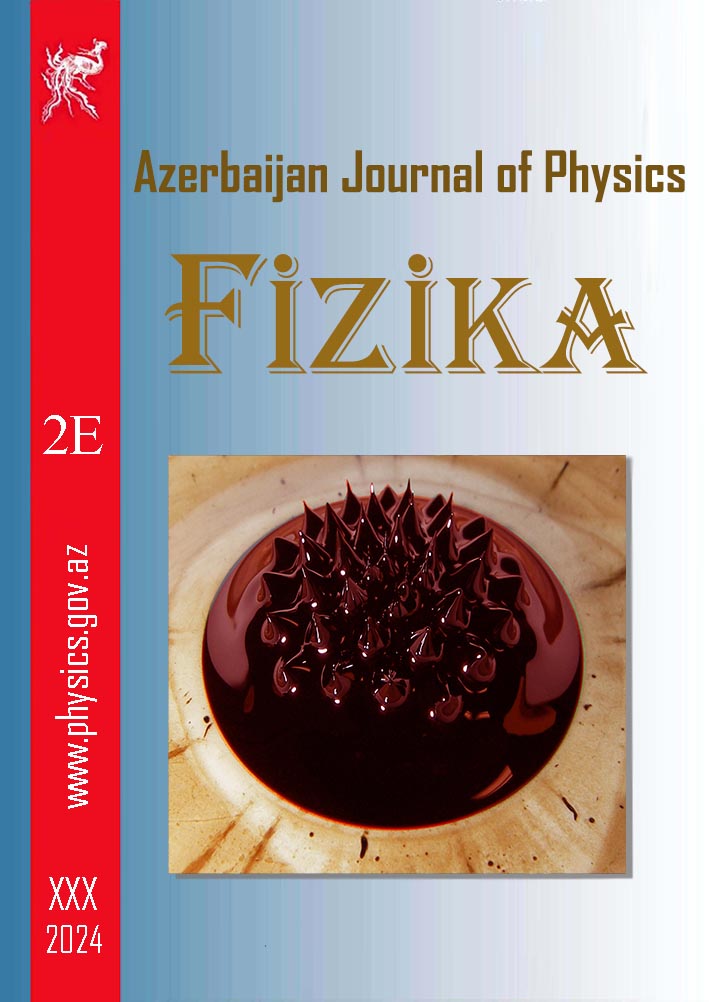ABSTRACT
The effect of hydrophilic and hydrophobic additives on the dielectric properties of agarose gel was studied by the method of low-frequency dielectric spectroscopy. It was
shown that the hydrophobic addition weakly changes the dielectric relaxation of the gel, while the hydrophilic addition shifts it towards lower frequencies. These
properties are related to changes in the viscosity of the solution.
Keywords: agarose, dielectric permeability, dielectric relaxation, viscosity
PACS: 72.22. Ej, 64.75 Bc, 31.70.Dk, 61.70 Og
DOI:-
Received: 28.11.2022
AUTHORS & AFFILIATIONS
Baku State University, 23, Z. Khalilov st., Baku, AZ 1148, Azerbaijan
E-mail: aynurasadova19@gmail.com
|
REFERENCIES
[1] Gels Handbook, ed. by Y. Osada and K. Kajiwara. 3 volume set, 2001, 1478p
[2] Polymer Gels: Perspectives and Applications ed by V.K. Thakur, M.K. Thakur, S.I. Voicu. Springer, 2018, 419p. 3.M. Djabou¬rov, K.Ni¬shi-nary, S.B. Ross-Murphy. Physical Gels from Biological and Synthetic Polymers, Cambridge University Press, 2018, 368 p
[3] Physics of Polymer Gels, ed. by T. Sakai, Wiley-VCH, 2020, 287p
[4] R.M. Ottenbrite, K. Park, T. Okano. Biomedical Applications of Hydrogels Handbook, Springer, 2010, 453p.
[5] K.C. Labropoulos, S. Rangarajan, D. E. Niesz, S. C. Danforth. Dynamic Rheology of Agar Gel Based Aqueous Binder, Journal of American Ceramic Society, 2001, 84, 6, 1217
[6] K.C. Labropolus, D.E.Niesz, S.C. Danforth, P.G.Kevrekidis. Dynamic rheology of agar gels: theory and experiments. Part I. Development of a rheological model, Carbohydrate Polymers, 2002, 50, p.393-406
[7] K.C. Labropolus, D.E. Niesz, S.C. Danforth, P.G.Kerrehidis. Dynamic rheology of agar gels: theory and experiments. Part II: gelation behavior of agar sols and fitting of a theoretical rheological model Garbohydrate Polymers, 2002, 50, p.407-415
[8] E.A. Foegeding, C. Gonzales, D.D. Hamann, S.Case. Polyacrylamide gels as elastic models for food gels, Hydrocolloids, 1994, 8(2), p.125-134
[9] U. Florjaneie, M. Zumer. Acta. Chem. Slov, 1998, 45 (4), p.419.
[10] U. Florjaneie, M. Zumer – Acta. Chem. Slov, 1998, 45 (4), p.407.
[11] A.J. de Kerchove, M. Elimelech. Macromolecules, Structural growth and viscoelastic properties of adsorbed alginate layers in monovalent and divalent salts, 2006, 39, p. 6558-6577
[12] K.A. Ross, L.J. Pyrak-Nolte, O.H. Campanella. The effect of mixing conditions on the material properties of an agar gel - microstructural and macrostructural considerations, Hydrocolloids, 2006, 20, p.79-87
[13] W. Richtering, K.D. Gagnon, R.W. Lenz, R.C. Fuller, H.H. Winter. – Physical gelation of a bacterial thermoplastic elastomer, Macromolecules, 1992, 25, p.2429-2933
[14] W.M. Kulicke, O. Arendt. Rheological characterization of the dilatant flow behavior of highly substituted hydroxypropylmethylcellulose solutions in the presence of sodium lauryl sulfate, Makrom.Chemie, 1998, 26, p.53-62
[15] Kh. Lahrech, A. Safonane, J. Peyerellase. Sol State Formation and Melting of Agar Gels Rheological Study, Physica A, 2005, 358, p.205
[16] J. Leor, S. Cohen. Miocardial Tissue Engineering: Creation of Muscle Patch for a Wounded Heart, Annals of New York Academy of Sciences, 2004, 1015, p.312
[17] J.P. Gong, Y. Katsuyama, T. Kurokawa, Y. Osada. Double-Network Hydrogels with Extremely High Mechanical Strength, Adv.Mater.,2003, 15, p.1155-1167
[18] A.R. Khokhlov. Adv Pol. Sci.: Responsive Gels, B: Springer Verlag, 1993, v109, p.275
[19] K.R. Gorur. Dielectrics in Electric Field, CRC Press, 2017, 774p
[20] J.M. Guenet. Polymer Solvent Molecular Compounds, Elsevier, 2008, 333 p
|
